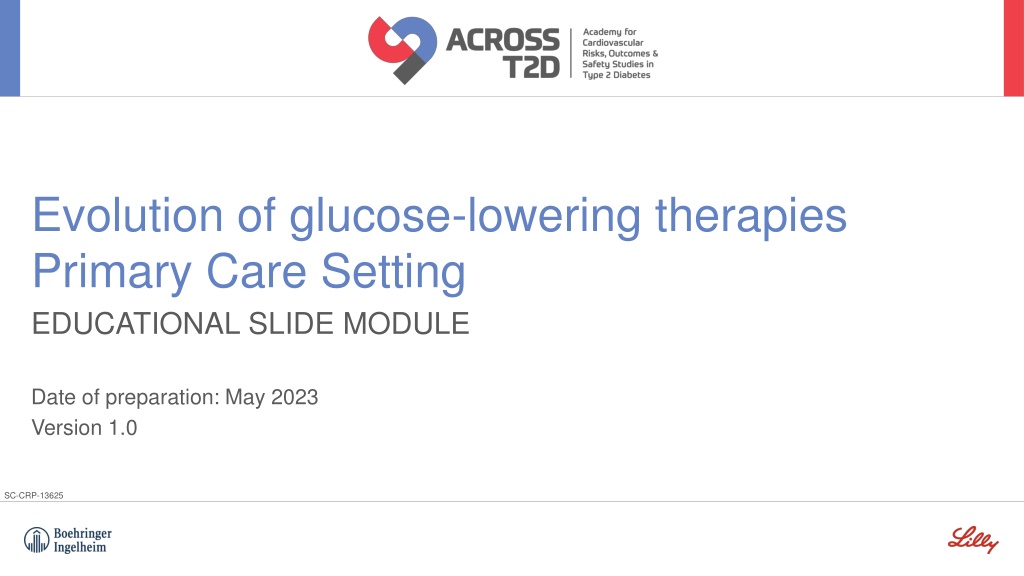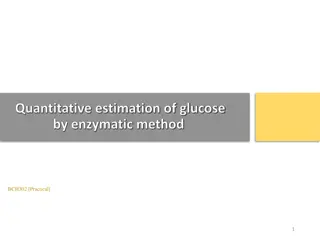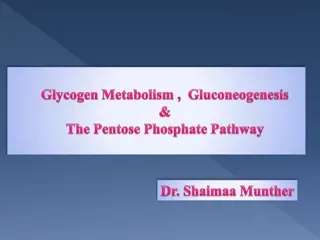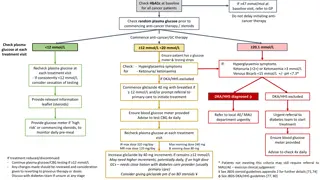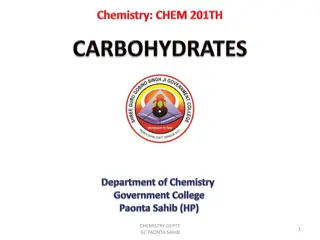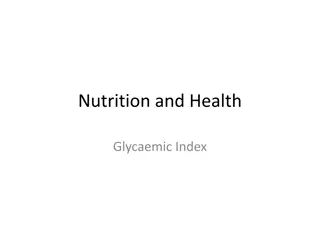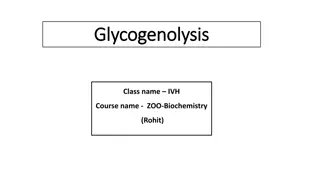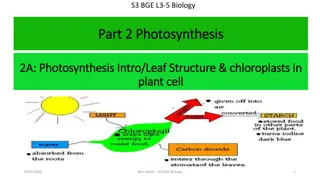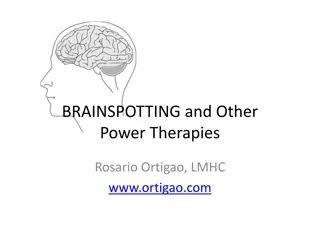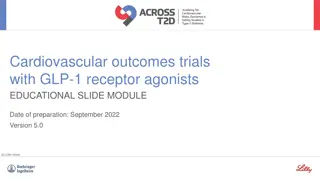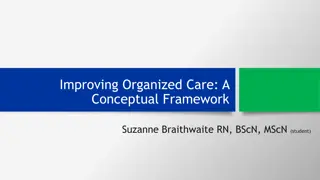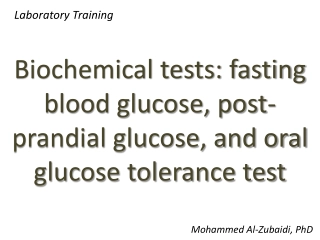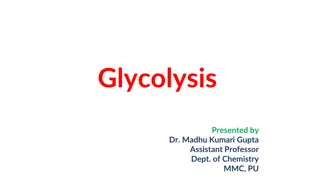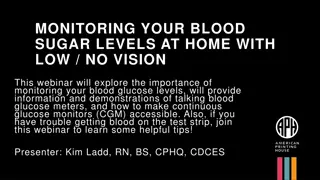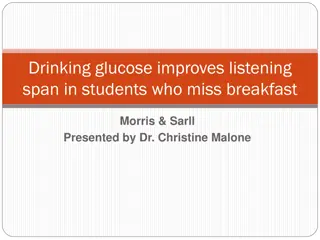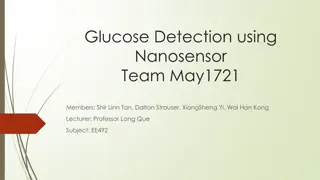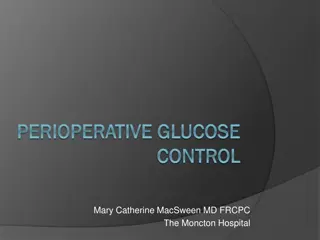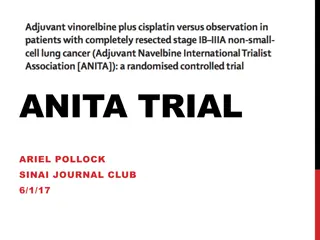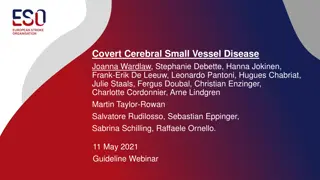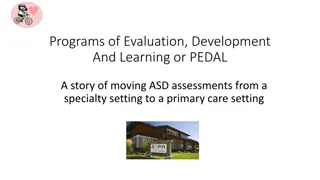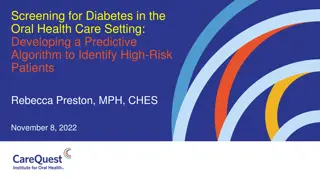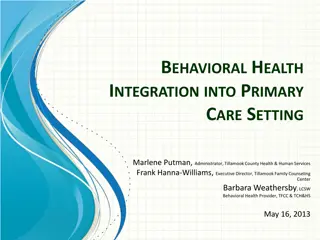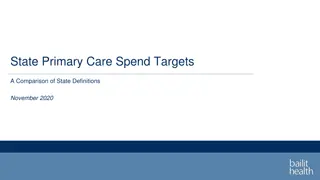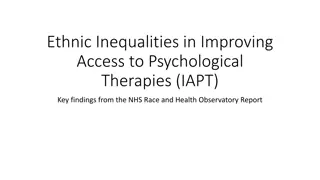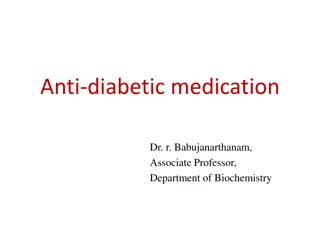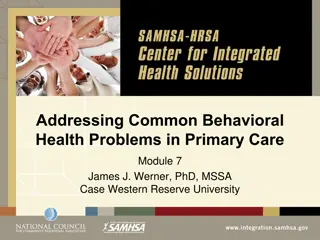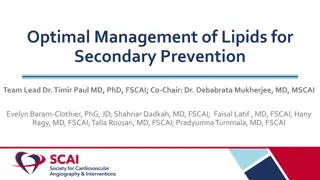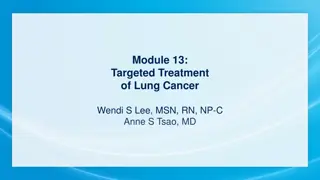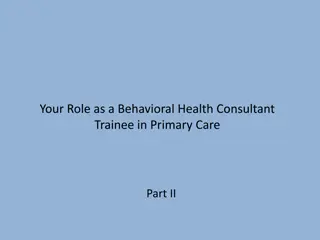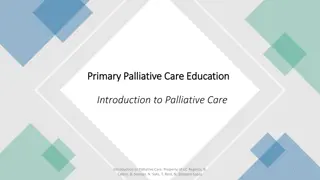Evolution of Glucose-Lowering Therapies in Primary Care Settings
Cardiovascular effects of older glucose-lowering therapies and the history of cardiovascular outcome trials are discussed in this educational slide module. It outlines the timeline of treatment options from the discovery of insulin to the introduction of various medications. Evidence regarding the cardiovascular benefits and risks associated with metformin, sulphonylureas, and TZDs is presented based on studies like PROactive, UKPDS, and RECORD. The limitations and findings of these studies highlight the complexity of managing diabetes while considering cardiovascular outcomes.
- Glucose Lowering Therapies
- Cardiovascular Effects
- Primary Care
- Diabetes Management
- Treatment Options
Download Presentation

Please find below an Image/Link to download the presentation.
The content on the website is provided AS IS for your information and personal use only. It may not be sold, licensed, or shared on other websites without obtaining consent from the author. Download presentation by click this link. If you encounter any issues during the download, it is possible that the publisher has removed the file from their server.
E N D
Presentation Transcript
Evolution of glucose-lowering therapies Primary Care Setting EDUCATIONAL SLIDE MODULE Date of preparation: May 2023 Version 1.0 Date goes here SC-CRP-13625
Contents Cardiovascular effects of older glucose-lowering therapies Cardiovascular effects of older glucose-lowering therapies Definition and history of cardiovascular outcome trials Definition and history of cardiovascular outcome trials Overview of cardiovascular outcome trials Overview of cardiovascular outcome trials Current guidelines and recommendations Current guidelines and recommendations
Contents Cardiovascular effects of older glucose-lowering therapies Cardiovascular effects of older glucose-lowering therapies Definition and history of cardiovascular outcome trials Definition and history of cardiovascular outcome trials Overview of cardiovascular outcome trials Overview of cardiovascular outcome trials Current guidelines and recommendations Current guidelines and recommendations
Cardiovascular effects of older glucose-lowering therapies Timeline of treatment options1 4 1920 1950 1960 1970 1980 1990 2000 2010 2012 2013 2014 Discovery of insulin Insulin lispro developed Insulin glargine4 Pioglitazone (TZD)4 Initial FDA approval of: -glucosidase inhibitors TZDs Lente insulins introduced Recombinant human insulin FDA approved Insulin degludec4 Metformin introduced to treat diabetes* Meglitinides Second- generation SUs first available in the US Third-generation SU (glimepiride) first available SUs first available Proven CV safety *Metformin approved (1994) and introduced (1995) in the US3 See slide notes for full list of references 4
Evidence of positive CV outcomes remains limited with older glucose-lowering therapies Metformin Sulphonylureas TZDs PROactive UKPDS 34 study Provided some evidence for the CV benefits of metformin in obese individuals1,2 UKPDS 33 study Significant reduction in 3P-MACE with pioglitazone8 No deleterious CV effects of SUs vs insulin or conventional therapy4 RECORD Meta-analysis of smaller trials suggested no consistent association with CV death or all-cause mortality5 Significant increase in HF with rosiglitazone, but no increase in MACE or mortality9 Paucity of evidence for metformin from large, long-term, placebo-controlled CVOTs3 TOSCA-IT6 Meta-analysis showed increased risk of MI with rosiglitazone10 Incidence of CV events similar with SUs compared with pioglitazone Increased risk of MI led to the EMA withdrawing rosiglitazone and the FDA restricting its use11 CAROLINA New CVOT following FDA guidance supported CV safety of glimepiride*7 Differing CV outcomes emphasise the need for compounds within the same class to demonstrate CV safety independently12 CV safety of most SUs* has not been established in long-term CVOTs; however, meta-analyses suggest heterogeneity of SUs on CV outcomes5 *CAROLINA tested the long-term CV safety profile of linagliptin versus glimepiride; Glibenclamide (2%), glimepiride (48%) and gliclazide (50%) 1. UKPDS 34. Lancet 1998;352:854; 2. Holman RR et al. N Engl J Med 2008;359:1577; 3. Boussageaon R et al. PLoS Med 2012;9:e1001204; 4. UKPDS 33. Lancet 1998;352:837; 5. Simpson SH et al. Lancet Diabetes Endocrinol 2015;3:43; 6. Vaccaro O et al. Lancet Diabetes Endocrinol 2017;5:887; 7. Rosenstock J et al. JAMA 2019;322:1155; 8. Dormandy JA et al. Lancet 2005;366:1279; 9. Home PD et al. Lancet 2009;373:2125;10. Nissen SE & Wolski K. N Engl J Med 2007;356:2457; 11. Nissen SE. Ann Intern Med 2012;157:671; 12. Rosenson RS et al. Am Heart J 2012;164:672 5
Contents Cardiovascular effects of older glucose-lowering therapies Cardiovascular effects of older glucose-lowering therapies Definition and history of cardiovascular outcome trials Definition and history of cardiovascular outcome trials Overview of cardiovascular outcome trials Overview of cardiovascular outcome trials Current guidelines and recommendations Current guidelines and recommendations
CV safety signals with glucose-lowering therapies led to new regulatory requirements in 2008 UGDP trial: tolbutamide discontinued due to increased CV mortality vs other treatment groups1 1970 Muraglitazar found to potentially increase CV risk during FDA assessment2 2005 Sponsor withdrew application1 Rosiglitazone associated with increased risk of MI and CV-related death3 Withdrawn in the EU1 Use restricted in the US*1 2007 ACCORD trial: intensive glucose lowering was associated with increased all-cause mortality4 HR 1.22 (95% CI 1.01, 1.46); p=0.04 2008 2008 New FDA requirements5 2012 New EMA requirements6 New glucose-lowering agents should demonstrate CV safety with meta-analysis or a CVOT *In 2013, the FDA reduced the safety restrictions on rosiglitazone.7 UGDP, University Group Diabetes Program 1. Nissen SE. Ann Intern Med 2012;157:671; 2. Nissen SE et al. JAMA 2005;294:2581; 3. Nissen SE et al. N Engl J Med 2007;356:2457; 4. ACCORD Study Group. N Engl J Med 2008;358:2545; 5. US Food and Drug Administration. Guidance for industry: diabetes mellitus evaluating cardiovascular risk in new antidiabetic therapies to treat type 2 diabetes. 2008. Available at: https://www.fda.gov/media/71297/download; 6. EMA. Guideline on clinical investigation. 2012. Available at: http://www.ema.europa.eu/docs/en_GB/document_library/Scientific_guideline/2012/06/WC500129256.pdf; 7. FDA. Drug Safety Communication on rosiglitazone- containing diabetes medicines. 2013. Available at: https://www.fda.gov/drugs/drug-safety-and-availability/fda-drug-safety-communication-fda-requires-removal-some- prescribing-and-dispensing-restrictions (all websites accessed Mar 2023) 7
CVOTs are required to evaluate the CV safety of new glucose-lowering therapies Adequately powered CV safety assessments should be conducted to demonstrate no increase in CV risk1,2 CVOT Meta-analysis Phase II and III trials designed and conducted to permit meta-analysis of safety events to be performed at completion Important CV events should be analysed Long-term data required (18 24 months follow-up) Prospective adjudication of CV events by an independent committee High-risk population to be included 1. FDA. Guidance for Industry. 2008. https://www.fda.gov/media/71297/download; 2. EMA. Guideline on clinical investigation of medicinal products in the treatment or prevention of diabetes mellitus. 2012. Available at: http://www.ema.europa.eu/docs/en_GB/document_library/Scientific_guideline/ 2012/06/WC500129256.pdf (all websites accessed Mar 2023) 8
Since the 2008 FDA mandate, more than 190,000 people have been enrolled in outcome trials1 DECLARE-TIMI 5817 Dapagliflozin N=17,160 3P-MACE and CV death or HHF FREEDOM-CVO8,9 ITCA 650 N=4156 4P-MACE SAVOR-TIMI 532 Saxagliptin N=16,492 EXSCEL12 Exenatide N=14,752 VERTIS CV20 Ertugliflozin N=8246 TECOS5 Sitagliptin N=14,671 4P-MACE EXAMINE3 Alogliptin N=5380 LEADER7 Liraglutide N=9340 CARMELINA13 Linagliptin N=6979 CAROLINA18 Linagliptin N=6041 AMPLITUDE-O21 Efpeglenatide N=4076 2013 2014 2015 2016 2017 2018 2019 2020 2021 ELIXA4 Lixisenatide N=6068 4P-MACE Harmony Outcomes14 Albiglutide N=9463 2024 CANVAS Program11 Canagliflozin N=10,142 SOUL22 Semaglutide (oral) N=9642 EMPA-REG OUTCOME6 Empagliflozin N=7020 SUSTAIN-610 Semaglutide (inj.) N=3297 REWIND15,16 Dulaglutide N=9901 PIONEER 619 Semaglutide (oral) N=3183 GLP-1 RA SGLT2 inhibitor DPP-4 inhibitor Markers on timeline represent trial completion except for SOUL (active, not recruiting), for which estimated trial completion dates are provided), all of which come from ClinicalTrials.gov. Primary endpoint is 3P-MACE unless indicated otherwise See slide notes for abbreviations and full list of references 9
Contents Cardiovascular effects of older glucose-lowering therapies Cardiovascular effects of older glucose-lowering therapies Definition and history of cardiovascular outcome trials Definition and history of cardiovascular outcome trials Overview of cardiovascular outcome trials Overview of cardiovascular outcome trials Current guidelines and recommendations Current guidelines and recommendations
Evidence from CVOTs has shown that some glucose-lowering therapies have beneficial effects on CV outcomes MACE BENEFIT NEUTRAL HARM BENEFIT DECLARE-TIMI 58 (dapagliflozin)3 VERTIS CV (ertugliflozin)4 EMPA-REG OUTCOME (empagliflozin)1 CANVAS Programme (canagliflozin)2 ELIXA (lixisenatide)9 EXSCEL (exenatide)10 PIONEER 6 (oral semaglutide)11 EXAMINE (alogliptin)12 TECOS (sitagliptin)13 CARMELINA (linagliptin)14 ORIGIN (insulin glargine)15 DEVOTE (degludec)16 ACE (acarbose)17 LEADER (liraglutide)5 SUSTAIN-6 (inj. semaglutide)6 Harmony Outcomes (albiglutide)7 REWIND (dulaglutide)8 NEUTRAL HHF* PROactive (pioglitazone) 18 RECORD (rosiglitazone) 19 SAVOR-TIMI 53 (saxagliptin)20 HARM Other SGLT2 inhibitor GLP-1 RA DPP-4 inhibitor TZD Comparison of trials should be interpreted with caution due to differences in study design, populations and methodology Empagliflozin is FDA-approved to 1) reduce the risk of CV death in adults with T2D and established CVD and 2) reduce the risk of CV death and HHF in adults with HF, and EMA-approved for the treatment of symptomatic chronic HF. Dapagliflozin is FDA-approved to 1) reduce the risk of HHF in adults with T2D and established CV disease or multiple CV risk factors and 2) reduce the risk of CV death and HHF in adults with HF with reduced ejection fraction, and EMA-approved for the treatment of symptomatic chronic HF Only GLP-1 receptor agonists included in the 2023 ADA Standards of Care21 are presented. PROactive and RECORD were conducted prior to the FDA mandate22 *Exploratory outcomes; Primary endpoint was time from randomisation to: all-cause mortality, non-fatal MI (including silent MI), stroke, acute coronary syndrome, endovascular or surgical intervention on the coronary or leg arteries, or amputation above the ankle; Primary endpoint was composite of CV death or CV hospitalisation. See slide notes for abbreviations and full list of references 11
Primary outcomes in completed SGLT2 inhibitor, GLP-1 RA and DPP-4 inhibitor CVOTs (MACE) in people with T2D FDA-mandated upper 95% CI for CV safety* p-value 0.04 0.02 0.17 <0.001 0.81 0.01 0.02 0.17 0.06 0.0006 0.026 0.99 0.315 0.84 <0.001 Drug class SGLT2 inhibitor Trial (study drug) EMPA-REG OUTCOME1 (empagliflozin) CANVAS Program2 (canagliflozin) DECLARE-TIMI 583 (dapagliflozin) VERTIS CV4 (ertugliflozin) ELIXA5 (lixisenatide) LEADER6 (liraglutide) SUSTAIN-67 (inj. semaglutide) PIONEER 6 8 (oral semaglutide) EXSCEL9 (exenatide) Harmony Outcomes10 (albiglutide) REWIND 11 (dulaglutide) SAVOR-TIMI 5312 (saxagliptin) EXAMINE13 (alogliptin) TECOS14 (sitagliptin) CARMELINA15 (linagliptin) HR (95% CI) 0.86 (0.74, 0.99) 0.86 (0.75, 0.97) 0.93 (0.84, 1.03) 0.97 (0.85, 1.11) 1.02 (0.89, 1.17) 0.87 (0.78, 0.97) 0.74 (0.58, 0.95) 0.79 (0.57, 1.11) 0.91 (0.83, 1.00) 0.78 (0.68, 0.90) 0.88 (0.79, 0.99) 1.00 (0.89, 1.12) 0.96 ( 1.16) 0.99 (0.89, 1.10) 1.02 (0.89, 1.17) GLP-1 RA DPP-4 inhibitor 1.3 1.8 0.25 0.5 1 2 Comparison of trials should be interpreted with caution due to differences in study design, populations and methodology CAROLINA is not included because it was an active comparator trial15 ELIXA and TECOS data are for 4P-MACE, all other data are for 3P-MACE *FDA-mandated upper 95% CI of the HR for CV safety is a margin of 1.3 for post-approval trials and 1.8 for pre-approval trials. SUSTAIN-6 and PIONEER 6 were pre-approval trials; 95.6% CI; 3P-MACE included death from unknown causes; Upper bound of the one-sided 95% CI, =0.01; p-value for non-inferiority, all others are for superiority See slide notes for full list of references Favours study drug Favours placebo 12
HHF outcomes in completed SGLT2 inhibitor, GLP-1 RA and DPP-4 inhibitor CVOTs in people with T2D p-value 0.002* NR NR NR 0.75 0.14 0.57 NR NR 0.113 0.46 0.007* 0.22 0.98 0.26 Drug class SGLT2 inhibitor Trial (study drug) EMPA-REG OUTCOME1 (empagliflozin) CANVAS Program2 (canagliflozin) DECLARE-TIMI 583 (dapagliflozin) VERTIS CV4 (ertugliflozin) ELIXA5 (lixisenatide) LEADER6 (liraglutide) SUSTAIN-67 (inj. semaglutide) PIONEER 68 (oral semaglutide) EXSCEL9 (exenatide) Harmony Outcomes 10 (albiglutide) REWIND 11 (dulaglutide) SAVOR-TIMI 5312 (saxagliptin) EXAMINE13 (alogliptin) TECOS**14 (sitagliptin) CARMELINA15 (linagliptin) HR (95% CI) 0.65 (0.50, 0.85) 0.67 (0.52, 0.87) 0.73 (0.61, 0.88) 0.70 (0.54, 0.90) 0.96 (0.75, 1.23) 0.87 (0.73, 1.05) 1.11 (0.77, 1.61) 0.86 (0.48, 1.55) 0.94 (0.78, 1.13) 0.85 (0.70, 1.04) 0.93 (0.77, 1.12) 1.27 (1.07, 1.51) 1.19 (0.90, 1.58) 1.00 (0.83, 1.20) 0.90 (0.74, 1.08) GLP-1 RA DPP-4 inhibitor 0.25 0.5 1 2 Favours study drug Favours placebo Comparison of trials should be interpreted with caution due to differences in study design, populations and methodology Empagliflozin is FDA-approved to 1) reduce the risk of CV death in adults with T2D and established CVD and 2) reduce the risk of CV death and HHF in adults with HF, and EMA-approved for the treatment of symptomatic chronic HF. Dapagliflozin is FDA-approved to 1) reduce the risk of HHF in adults with T2D and established CV disease or multiple CV risk factors and 2) reduce the risk of CV death and HHF in adults with HF with reduced ejection fraction, and EMA- approved for the treatment of symptomatic chronic HF. CAROLINA is not included because it was an active comparator trial15 *Nominal p-value; p-value not reported in publication; CV death or HHF was a composite secondary endpoint; HHF data alone were not reported in the primary publication; HF outcome was hospital admission for HF or urgent visit; Post hoc analysis value; **Adjusted for history of HF at baseline See slide notes for abbreviations and full list of references 13
Only empagliflozin and liraglutide have demonstrated benefits in CV death* in people with T2D p-value <0.001 NR NR NR 0.85 0.007 0.92 NR NR 0.578 0.21 0.72 0.212** 0.71 0.63 Drug class SGLT2 inhibitor Trial (study drug) EMPA-REG OUTCOME1 (empagliflozin) CANVAS Program2 (canagliflozin) DECLARE-TIMI 583 (dapagliflozin) VERTIS CV4 (ertugliflozin) ELIXA4 (lixisenatide) LEADER5 (liraglutide) SUSTAIN-66 (inj. semaglutide) PIONEER 67 (oral semaglutide) EXSCEL 8 (exenatide) Harmony Outcomes9 (albiglutide) REWIND 10 (dulaglutide) SAVOR-TIMI 5311 (saxagliptin) EXAMINE12 (alogliptin) TECOS13 (sitagliptin) CARMELINA14 (linagliptin) HR (95% CI) 0.62 (0.49, 0.77) 0.87 (0.72, 1.06) 0.98 (0.82, 1.17) 0.92 (0.77, 1.11) 0.98 (0.78, 1.22) 0.78 (0.66, 0.93) 0.98 (0.65, 1.48) 0.49 (0.27, 0.92) 0.88 (0.76, 1.02) 0.93 (0.73, 1.19) 0.91 (0.78, 1.06) 1.03 (0.87, 1.22) 0.85 (0.66, 1.10) 1.03 (0.89, 1.19) 0.96 (0.81, 1.14) GLP-1 RA DPP-4 inhibitor 0.25 0.5 1 2 Favours study drug Favours placebo Comparison of trials should be interpreted with caution due to differences in study design, populations and methodology Empagliflozin is FDA-approved to 1) reduce the risk of CV death in adults with T2D and established CVD and 2) reduce the risk of CV death and HHF in adults with HF, and EMA-approved for the treatment of symptomatic chronic HF. Dapagliflozin is FDA-approved to 1) reduce the risk of HHF in adults with T2D and established CV disease or multiple CV risk factors and 2) reduce the risk of CV death and HHF in adults with HF with reduced ejection fraction, and EMA-approved for the treatment of symptomatic chronic HF. CAROLINA is not included because it was an active comparator trial15 *CV death was an exploratory outcome in all CVOTs; Nominal p-value; p-value not reported in publication; 95.8% Cl; Includes death from unknown causes; **Post hoc analysis value; NR, not reported See slide notes for full list of references 14
Hard kidney outcomes and albuminuria in completed CV, cardio renal and HF trials in people with T2D Hard kidney outcomes* BENEFIT NEUTRAL HARM BENEFIT Empagliflozin (EMPA-REG OUTCOME1) Canagliflozin (CANVAS,2 CREDENCE3) Dapagliflozin (DECLARE-TIMI 58,4 DAPA-HF5) LEADER (liraglutide)6 SUSTAIN-6 (inj. semaglutide)7 REWIND (dulaglutide)8 CARMELINA (linagliptin)9 Albuminuria NEUTRAL EXSCEL (exenatide)10 SAVOR-TIMI 53 (saxagliptin)11 HARM SGLT2 inhibitor GLP-1 RA DPP-4 inhibitor Comparison of trials should be interpreted with caution due to differences in study design, populations and methodology Canagliflozin is FDA-approved to reduce the risk of ESKD, doubling of serum creatinine, CV death, and HHF in adults with T2D and diabetic nephropathy with albuminuria >300 mg/day. Dapagliflozin is FDA-approved to reduce the risk of sustained eGFR decline, ESKD, CV death and hospitalization for HF in adults with CKD at risk of progression and EMA-approved for the treatment of CKD *Exploratory outcomes in all trials except for CREDENCE; hard kidney outcomes were most commonly doubling of serum creatinine or need for chronic dialysis, end-stage kidney disease and death due to kidney causes; In CREDENCE, persons were required to have CKD, defined as eGFR 30 to <90 ml/min/1.73m2 and albuminuria; the primary composite outcome was end-stage kidney disease, sustained doubling of serum creatinine, or death due to kidney causes or CV death3 See slide notes for abbreviations and full list of references 15
Composite kidney outcomes in SGLT2 inhibitor, GLP-1 RA and DPP-4 inhibitor CVOTs Patients Events Weights (%) HR (95% CI) HR (95% CI) SGLT2 inhibitor* 1 6185 913 EMPA-REG OUTCOME (empagliflozin) 0.61 (0.53, 0.70) 24.9 10,142 847 CANVAS Program (canagliflozin) 25.0 0.57 (0.50, 0.66) 17,160 1675 DECLARE-TIMI 58 (dapagliflozin) 50.1 0.66 (0.60, 0.73) GLP-1 RA1* 5286 375 ELIXA (lixisenatide) 20.0 0.84 (0.68, 1.02) 9340 605 LEADER (liraglutide) 32.2 0.78 (0.67, 0.92) 3297 162 SUSTAIN-6 (inj. semaglutide) 7.7 0.64 (0.46, 0.88) 14,752 773 EXSCEL (exenatide) 40.1 0.88 (0.76, 1.01) 9901 1338 REWIND (dulaglutide)2 0.76 (0.68, 0.84) DPP-4 inhibitor 6979 633 CARMELINA(linagliptin)3 1.04 (0.89, 1.22) 0.25 0.5 1 2 Comparison of trials should be interpreted with caution due to differences in study design, populations and methodology p-value for subgroup differences between SGLT2 inhibitors and GLP-1 RAs was 0.01 *New-onset macroalbuminuria, sustained doubling of serum creatinine or a 40% decline in eGFR, end-stage kidney disease or death due to kidney causes; Q statistic=2.99; p=0.22, I2=33.2%; Q statistic =3.60; p=0.31, I2=16.6%(excluding REWIND) 1. Zelniker TA et al. Circulation 2019;139:2022; 2. Gerstein HC et al. Lancet 2019;394:131; 3. Rosenstock J et al. JAMA 2019;321:69 Favours study drug Favours placebo 16
Hard kidney outcomes in SGLT2 inhibitor, GLP-1 RA and DPP-4 inhibitor CVOTs Patients Events Weights (%) HR (95% CI) HR (95% CI) SGLT2 inhibitor* 1 6968 152 EMPA-REG OUTCOME (empagliflozin)2 20.9 0.54 (0.40, 0.75) 10,142 249 CANVAS Program (canagliflozin)3 34.0 0.60 (0.47, 0.77) 17,160 365 DECLARE-TIMI 58 (dapagliflozin)4 45.1 0.53 (0.43, 0.66) 8246 283 VERTIS CV (ertugliflozin)5 0.81 (0.63, 1.04) GLP-1 RA* 1 6063 76 ELIXA (lixisenatide)6 9.5 1.16 (0.74, 1.83) 9340 184 LEADER (liraglutide)7 23.4 0.89 (0.67, 1.19) 3297 32 SUSTAIN-6 (inj. semaglutide)8 4.0 1.28 (0.64, 2.58) 12,914 519 EXSCEL (exenatide)9 63.1 0.88 (0.74, 1.05) DPP-4 inhibitor 16,492 372 SAVOR-TIMI 53 (saxagliptin) 10 1.08 (0.88, 1.32) 6979 633 CARMELINA (linagliptin)**11 1.04 (0.89, 1.22) 0.25 0.5 1 2 Comparison of trials should be interpreted with caution due to differences in study design, populations and methodology p-value for subgroup differences between SGLT2 inhibitors and GLP-1 RAs was <0.001 *Sustained doubling of serum creatinine or a 40% decline in eGFR, end-stage kidney disease or death due to kidney causes; Q statistic=0.59; p=0.74, I2=0%; 95.8% Cl; Q statistic= 2.18; p=0.54, I2=0%; Doubling of serum creatinine, initiation of dialysis, renal transplantation, or creatinine >6.0 mg/dl; **Sustained ESKD, sustained 40% decrease in eGFR from baseline or death due to kidney disease. See slide notes for abbreviations and references Favours study drug Favours placebo 17
Contents Cardiovascular effects of older glucose-lowering therapies Cardiovascular effects of older glucose-lowering therapies Definition and history of cardiovascular outcome trials Definition and history of cardiovascular outcome trials Overview of cardiovascular outcome trials Overview of cardiovascular outcome trials Current guidelines and recommendations Current guidelines and recommendations
Evidence from SGLT2 inhibitor and GLP-1 RA outcome trials has led to major updates in clinical recommendations and guidelines Timeline of outcome trial data release and updates to clinical recommendations and guidelines Harmony Outcomes5 Albiglutide LEADER2 Liraglutide CREDENCE7 Canagliflozin GLP-1 RA SGLT2 inhibitor EMPA-REG OUTCOME1 Empagliflozin CANVAS Program4 Canagliflozin SUSTAIN-63 Semaglutide REWIND8 Dulaglutide DAPA-HF9 Dapagliflozin DECLARE-TIMI 586 Dapagliflozin 2015 2016 2017 2018 2019 2020 2021 2022 Diabetes Semaglutide Canagliflozin Jan 201814 Risk-specific recommendations Jan 202120 Semaglutide Canagliflozin Apr 201815 SGLT2i, GLP-1 RA benefits Dec 2019/Jan 202018,19 Four*/five CVOTs Oct 2018/Jan 201916,17 Metformin optional Jan 202221 Empagliflozin Feb 201610 Liraglutide Sep 201611 Liraglutide Jan 201712 Four* CVOTs Oct 201713 CVD/HF SGLT2i, GLP-1 RA benefits Sep 202030 SGLT2i, GLP-1 RA benefits Sep 202131 SGLT2i irrespective of T2D presence May 202232 Empagliflozin May 201622 Empagliflozin May 201623 Empagliflozin Aug 201724 Canagliflozin Mar 201825 Four CVOTs Nov 2018*26 Six CVOTs Mar 2019 27 Six CVOTs Sep 2019 28 SGLT2i benefits Sep 201917,26,29 CKD with T2D SGLT2 inhibitor CVOTs Feb 2019 33 SGLT2 inhibitor benefits Oct 202034 *EMPA-REG OUTCOME, LEADER, SUSTAIN-6 and CANVAS Program; EMPA-REG OUTCOME, LEADER, SUSTAIN-6, CANVAS Program and Harmony Outcomes; GLP-1 RA are also recommended but lack evidence of direct benefit on hard kidney outcomes; EMPA-REG OUTCOME, LEADER, SUSTAIN-6, CANVAS Program, Harmony Outcomes and DECLARE TIMI-58; EMPA- REG OUTCOME, LEADER, SUSTAIN-6, CANVAS Program, REWIND and DECLARE TIMI-58; **For people with T2D, CKD and an eGFR 20 ml/min per 1.73 m2 35 See slide notes for full list of references 19
Guidelines and societies recommend the use of SGLT2i and/or GLP-1 RAs for their metabolic, CV and kidney benefits 2023 As initial therapy in T2D with or at high risk of ASCVD, HF or CKD for cardio-renal risk reduction17 2022 As initial therapy in T2D with or at high risk of ASCVD,13 HF13 or CKD13,14 Reduce HHF and CV death in people with symptomatic chronic HFrEF (class 1), HFmrEF (class 2a) and HFpEF (class 2a), independent of T2D status*15 Results of CV and kidney outcome trials (including subgroup analyses) inform broader recommendations for cardio-renal protection in people with T2D at high risk of CVD16 2021 2020 CV and mortality benefits in people with T2D at high risk of CV events or with HFrEF12 2019 Independent of HbA1c; ASCVD, HF or CKD predominates (in people with T2D)11 2018 Kidney benefits in people with T2D + CKD + DKD8 10 2016 Benefits in ASCVD and chronic HF in people with T2D7 2015 CV and mortality benefits in people with T2D and CV disease3 6 Glycaemic control in T2D1,2 *Class denotes strength of recommendation: class 1 = strong; class 2a = moderate17 For full recommendations, please refer to the individual references and guidelines or the AT2D module Evolving evidence-based recommendations in T2D ASCVD, atherosclerotic cardiovascular disease; CVD, cardiovascular disease; DKD, diabetic kidney disease; HFmrEF, heart failure with mildly reduced ejection fraction; HFpEF, heart failure with preserved ejection fraction; HFrEF, heart failure with reduced ejection fraction; HHF, hospitalisation for heart failure See slide notes for full list of references 20
What are the implications of CVOT data for the management of people with T2D as recommended in clinical guidelines? 21
There are several treatment options ranked by level of efficacy for glycaemic and weight management for people with T2D To avoid therapeutic inertia reassess and modify treatment regularly (3 6 months) ADA 2023 Standards of Medical Care and ADA EASD Consensus Report1,2: Goal achievement and maintenance of glycaemic and weight management goals Glycaemia management: choose approaches that provide the efficacy to achieve goals Achievement and management of weight-management goals Set individualised weight-management goals and consider: Lifestyle advice Medication for weight loss Metabolic surgery Weight-management programme Metformin OR agent(s) including combination therapy that provide adequate efficacy to achieve and maintain goals Consider a glucose-lowering regimen with high-to-very-high dual glucose and weight efficacy Consider avoidance of hypoglycaemia a priority in high-risk individuals Efficacy for glucose lowering Efficacy for weight loss Very high: Dulaglutide (high dose), semaglutide, tirzepatide Insulin, combination oral, combination injectable (GLP-1 RA/insulin) High: GLP-1 RA (not listed above), metformin, SGLT2 inhibitor, sulphonylurea, TZD Very high: Semaglutide, tirzepatide High: Dulaglutide, liraglutide Intermediate: GLP-1 RA (not listed above), SGLT2 inhibitor Intermediate: DPP-4i Neutral: DPP-4i, metformin Identify barriers to goals if HbA1c is above target Figure adapted from the ADA-EASD consensus report. Davies MJ et al. Diabetes Care 2022;45:2753. There are additional recommendations If HbA1c remains above target; for full recommendations, please refer to the reference. TZD, thiazolidinedione. 1. American Diabetes Association. Diabetes Care 2023;46:S1; 2. Davies MJ et al. Diabetes Care 2022;45:2753 22
SGLT2 inhibitors are recommended as a first-line treatment option in the management of people with T2D at high risk of cardio-renal events To avoid therapeutic inertia, reassess and modify treatment regularly (3 6 months) ADA 2023 Standards of Medical Care and ADA EASD Consensus Report1,2: Goal cardio-renal risk reduction in high-risk people with T2D*, +ASCVD/indicators of high risk +CKD +HF People with HF People with ASCVD/indicators of high risk GLP-1 RA with proven CVD benefit People with CKD (on maximally tolerated dose of ACEi/ARB) Preferably SGLT2 inhibitor with primary evidence of reducing CKD progression SGLT2 inhibitor with proven CVD benefit GLP-1 RA with proven CV benefit if SGLT2 inhibitor not tolerated or contraindicated Either/ or SGLT2 inhibitor with proven benefit in this population Use SGLT2 inhibitor in people with an eGFR 20 ml/min per 1.73 m2; once initiated, should be continued until dialysis or transplantation If HbA1c above target Or For individuals on a GLP-1 RA consider adding SGLT2 inhibitor with proven CVD benefit or vice versa TZD** If HbA1c above target, for individuals on SGLT2 inhibitor, consider incorporating a GLP-1 RA or vice versa Identify barriers to goals if additional cardio-renal risk reduction or glycaemic-lowering needed Figure adapted from ADA-EASD consensus report. Davies MJ et al. Diabetes Care 2022;45:2753. There are additional recommendations If HbA1c remains above target; for full recommendations, please refer to the reference. For full recommendations, please refer to the reference Please see speaker notes for footnotes, abbreviations and references 23
ADA 2023 Standards of Medical Care includes several treatment options for people with T2D and CKD ADA 2023 Standards of Medical Care in Diabetes: adults with T2D and CKD +CKD 11.5a For people with T2D and DKD, use of an SGLT2 inhibitor is recommended to reduce CKD progression and CV events in people with an eGFR rate 20 ml/min/1.73 m2 and urinary albumin 200 mg/g creatinine. A 11.5c In people with T2D and DKD, consider use of SGLT2 inhibitors (if eGFR rate is 20 ml/min/1.73 m2), or a GLP-1 RA or non-steroidal MRA (if eGFR 25 ml/min/1.73 m2) additionally for CV risk reduction. A 11.5d In people with CKD and albuminuria who are at increased risk for CV events or CKD progression, a non- steroidal MRA shown to be effective in clinical trials is recommended to reduce CKD progression and CV events. A 10.43 For people with T2D and CKD with albuminuria and treated with maximum tolerated doses of ACE inhibitor or ARB, addition of finerenone is recommended to improve CV outcomes and reduce the risk of CKD progression. A People with CKD (on maximally tolerated dose of ACEi/ARB) Preferably SGLT2 inhibitor* with primary evidence of reducing CKD progression GLP-1 RA with proven CV benefit if SGLT2 inhibitor not tolerated or contraindicated Use SGLT2 inhibitor in people with an eGFR 20 ml/min per 1.73 m2; once initiated, should be continued until dialysis or transplantation Or If HbA1c above target, for individuals on SGLT2 inhibitor, consider incorporating a GLP-1 RA or vice versa (A) refers to the level of evidence in the ADA evidence grading system. To consult the ADA evidence grading system 2023, please refer to page 9 of the reference *For SGLT2 inhibitors, CV/renal outcome trials demonstrate their efficacy in reducing the risk of composite MACE, CV death and ACM, MI, HHF and renal outcomes in individuals with T2D with established/high risk of CVD ACEi, angiotensin-converting enzyme inhibitors; ACM, all-cause mortality; ARB, angiotensin receptor blockers; ASCVD, atherosclerotic cardiovascular disease; CVD, cardiovascular disease; DKD, diabetic kidney disease; MRA, mineralocorticoid receptor antagonist American Diabetes Association. Diabetes Care 2023;46:S1 24
ADA guideline recommendations include CV disease and kidney disease risk management in T2D ADA Standards of Medical Care in Diabetes, 2023 CV effects Kidney effects In people with T2D who have established ASCVD, multiple ASCVD disease risk factors or DKD, an SGLT2 inhibitor with demonstrated CV disease benefit is recommended to reduce the risk of MACE and/or HHF/HF (A) Weight change Efficacy Hypoglycaemia Progression of DKD Effect of MACE HF Neutral (potential for modest loss) Potential benefit High No Neutral Neutral Metformin Benefit: empagliflozin, canagliflozin, dapagliflozin, ertugliflozin In people with T2D who have established ASCVD, multiple ASCVD disease risk factors or DKD, a GLP-1 RA with demonstrated CV disease benefit is recommended to reduce the risk of MACE and/or HHF/HF (A) Benefit: canagliflozin, empagliflozin, dapagliflozin Benefit: empagliflozin,* canagliflozin Intermediate to high SGLT2 inhibitors No Loss Neutral: Exenatide qw, lixisenatide Benefit: liraglutide, injectable semaglutide s.c., dulagtutide High to very high For people with T2D and DKD, use of an SGLT2 inhibitor is recommended to reduce CKD progression and CV events in individuals with an eGFR 20 ml/min/1.73 m2 and urinary albumin ranging from normal to 200 mg/g creatinine (A) Benefit: Dulaglutide, liraglutide, injectable semaglutide No Loss Neutral GLP-1 RAs *FDA-approved for CV disease benefit; FDA-approved for heart failure indication; FDA-approved for CKD indication; FDA-approved for CV disease benefit; (A) refers to the level of evidence in the ADA evidence-grading system ASCVD, atherosclerotic cardiovascular disease; DKD, diabetic kidney disease; HHF, hospitalisation for heart failure; s.c., subcutaneous American Diabetes Association. Diabetes Care 2023;46:S1 25
ACC ECDP 2020 and KDIGO 2022 recommend the use of SGLT2 inhibitors in people with T2D ACC Expert Consensus Decision Pathway (2020)1 CV specialists should be aware of the evidence supporting the use of specific SGLT2 inhibitors and GLP-1 RAs to reduce risk in people with T2D and established CV disease and should be both champions and change agents as strong advocates for our patients, recognising unmet needs in healthcare delivery, and extending our comfort zone in implementing the use of new evidence-based therapies that reduce CV event rates KDIGO Clinical Practice Guideline for Diabetes Management in Chronic Kidney Disease (2022)2 recommend treating people with T2D, CKD, and an eGFR 20 ml/min per 1.73 m2with an SGLT2 inhibitor and if persons are already being treated with other glucose-lowering agents, an SGLT2 inhibitor can be added to the current treatment regimen 1. Das SR et al. J Am Coll Cardiol 2020;76:1117; 2. Kidney Disease: Improving Global Outcomes (KDIGO) Diabetes Work Group. Kidney Int Suppl 2022;102:S1 26
Global clinical guidelines, societies and associations recommend the use of SGLT2 inhibitors in people with T2D and CKD recommend treating people with T2D, CKD, and an eGFR 20 ml/min per 1.73 m2 with an SGLT2 inhibitor 1 For people with T2D and DKD, use of an SGLT2 inhibitor is recommended to reduce CKD progression and CV events in people with an eGFR rate 20 ml/min/1.73 m2 and urinary albumin 200 mg/g creatinine 2 In people with T2D and CKD, the use of an SGLT2 inhibitor is recommended to improve CV disease and/or cardiorenal outcomes 3 CKD, chronic kidney disease; CV, cardiovascular; DKD, diabetic kidney disease; eGFR, estimated glomerular filtration rate; SGLT2, sodium-glucose co-transporter-2 1. Kidney Disease: Improving Global Outcomes (KDIGO) Diabetes Work Group. Kidney Int Suppl 2022;102:S1; 2. American Diabetes Association. Diabetes Care 2023;46:S1; 3. Visseren FLJ et al. Eur Heart J 2021;42:3227 27
Global clinical guidelines, societies and associations recommend the use of SGLT2 inhibitors in people with T2D and HF An SGLT2 inhibitor is recommended as initial therapy in T2D with, or at high risk of, ASCVD, HF or CKD1 Reduce HHF and CV death in people with symptomatic chronic HFrEF (class 1), HFmrEF (class 2a) and HFpEF (class 2a), independent of T2D status*2 In people with HF and T2D, the use of SGLT2 inhibitor is recommended for the management of hyperglycaemia and to reduce HF-related morbidity and mortality 2 *Class denotes strength of recommendation: class 1 = strong; class 2a = moderate2 AHA, American Heart Association; ASCVD, atherosclerotic cardiovascular disease; HFSA, Heart Failure Society of America 1. American Diabetes Association. Diabetes Care 2023;46:S1; 2. Heidenreich PA et al. Circulation 2022;145:e895 28
Evolution of glucose-lowering therapies: summary Based on inconclusive evidence and CV safety warnings with older glucose-lowering agents, in 2008 the FDA mandated that new diabetes drugs demonstrate CV safety in CVOTs1 In people with T2D, SGLT2 inhibitors and GLP-1 RAs* have been shown to improve metabolic risk factors and reduce the risk of CV, HF (SGLT2 inhibitors only) and kidney complications (SGLT2 inhibitors and specific GLP-1 RAs )2 Recommendations from clinical guidelines and position statements have been updated to reflect the latest evidence for reducing the risk of CV mortality for people with T2D3 17 Completed18 24 trials of SGLT2 inhibitors add to the evidence base, including investigating their effects on HF and CKD outcomes in people with and without T2D *GLP-1 RAs have neutral effect on HF; Liraglutide, semaglutide s.c. and dulaglutide HHF, hospitalisation for heart failure See slide notes for full list of references 29
